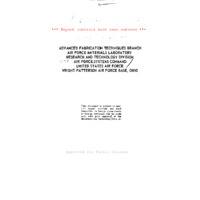-
Title
-
Shielded Ceramic Composite Structure
-
Date
-
1965
-
Index Abstract
-
Not Available
-
Photo Quality
-
Complete
-
Report Number
-
AFML TR 65-331
-
Creator
-
Kummer, Donald L.
-
Rosenthal, Jerome J.
-
Lum, David W.
-
Corporate Author
-
McDonnell Aircraft Corp St Louis MO
-
Laboratory
-
Air Force Materials Laboratory
-
Extent
-
412
-
Identifier
-
AD0475002
-
Access Rights
-
Export Control
-
Distribution Classification
-
1
-
Contract
-
AF 33(657)-10996
-
DoD Project
-
7997
-
DoD Task
-
None Given
-
DTIC Record Exists
-
No
-
Distribution Change Authority Correspondence
-
AFML LTR
-
Distribution Conflict
-
No
-
Abstract
-
Alumina, zirconia, and thoria were selected for use in composite ceramic heat shields for the leading surfaces of lifting orbital re-entry vehicles. Coated columbium and molybdenum were selected for substructure materials. Commercially available low and high density alumina, zirconia, and thoria ceramics were evaluated for thermal shock resistance; and many high density, but no low density ceramics were found to be satisfactory. A sintered low density (95 lb/ft^3) thermal shock resistace zirconia was developed, but it was difficult to reproducibly manufacture. A sintered low density (125 lb/ft^3) thoria was developed that had low thermal shock resistance but could be reproducibly manufactured. Chemically bonded low and high density thermal shock resistant varieties of alumina, zirconia, and thoria were developed. Thermophysical properties were determined to temperatures as high as 4500 F for the ceramics utilized in this project. Analytical techniques were derived for predicting the thermal stress behavior of ceramics. Twenty-two subscale heat shield modules and three full size components were designed, fabricated and environmentally tested. The full size components were a 3.0 inch radius, 3400F leading edge; a 1.5 inch radius, 4000F leading edge; anda 6.0 radius, 5000F nose cap. The ceramic phase densities for these components were 57 lb/ft^, 97 lb/ft^3, and 166 lb/ft^3 respectively. Satisfactory techniques were developed for processing, fabricating, and assembling ceramic heat shields. Typical launch vibration and acoustical environmental conditions were not found to be critical, but re-entry thermal environment was found to be very critical. A MAPP-0X thermal test facility was developed for full scale testing. The 1.5 inch radius leading edge survived thermal testing although testing was prematurely terminated due to a test fixture failure. During thermal testing, the 3.0 inch readius leading edge cracked but remained intact and did not spall; and the 6.0 inch radius nose cap underwent severe surface erosion. These two failures were attributed to a combination of design and material shortcomings and the severity of the MAPP-0X thermal test environment.
-
Report Availability
-
Full text available
-
Date Issued
-
1965-10
-
Provenance
-
Lockheed Martin Missiles & Fire Control
-
Type
-
report
-
Format
-
1 online resource
 AFMLTR65-331.pdf
AFMLTR65-331.pdf